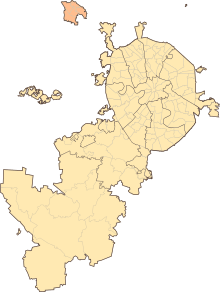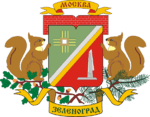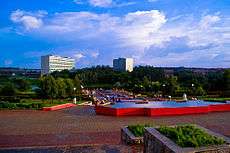Zelenograd
| Zelenograd Зеленоград (Russian) | |
|---|---|
|
- City[1] - Administrative Okrug of Moscow[1] | |
 Views of Zelenograd | |
 Zelenograd in Moscow | |
 |
.svg.png) |
Coat of arms |
Flag |
| Administrative status | |
| Country | Russia |
| Federal subject | Moscow |
| Administratively subordinated to | Moscow[1] |
| Municipal status | |
| Prefect[2] | Anatoly Smirnov[2] |
| Statistics | |
| Area | 37.22 km2 (14.37 sq mi)[3] |
| Population (2010 Census) | 221,712 inhabitants[4] |
| Density | 5,957/km2 (15,430/sq mi)[5] |
| Time zone | MSK (UTC+03:00)[6] |
| Founded | March 3, 1958 |
| City status since | January 15, 1963 |
| Postal code(s)[7] | 124xxx |
| Dialing code(s) | +7 (495), (499)[8] |
| Website |
zelao |
| Zelenograd on Wikimedia Commons | |
Zelenograd (Russian: Зеленогра́д, IPA: [zʲɪlʲɪnɐˈgrat], lit. green city) is a city and administrative okrug of Moscow, Russia.[1] The city of Zelenograd and the territory under its jurisdiction form the Zelenogradsky Administrative Okrug (ZelAO), an exclave located within Moscow Oblast 37 kilometers (23 mi) north-west of central Moscow along the Leningradskoye Shosse highway. Zelenograd is the smallest administrative okrug of Moscow by area, and the largest Moscow exclave by area and population within Moscow Oblast.[1] The city of Zelenograd, if it were a separate settlement, would be 5th largest city in Moscow Oblast and one of the 100 largest cities of Russia.
Zelenograd was founded in 1958 as a new town in the Soviet Union, developed as a center of electronics, microelectronics and the computer industry known as "Soviet/Russian Silicon Valley", and remains an important center of electronics in modern Russia. The city color is green and its emblematic animal is the squirrel (more precisely Sciurus vulgaris).
History
Zelenograd was founded in 1958 as an unnamed planned city near the village and railway station of Kryukovo on a previously empty, forested place, and its architecture and civic layout yields to one general architectural plan (chief architects Igor Rozhin (1956–1963), then Igor Pokrovsky (1963–2002)), which has appreciable influence from garden city movement, development of Finish Tapiola district and new towns in the United Kingdom (Harlow and others).
The city was planned as a center of the textile industry initially, but in 1962, Alexander Shokin (Chairman of State Committee of Electronic Technology, then first Minister of Electronic Technology) proposed to change the line of future city business to electronics. Some researchers of Soviet electronics history mentioned that a similar idea was proposed to the Soviet government by two fugitive Silicon Valley engineers - Alfred Sarant (more known in Russia as Philip Staros) and Joel Barr (Joseph Berg).
On January 15, 1963 the city received official city status and name Zelenograd, and on November 25, 1968 Zelenograd received the status of district of Moscow (one of the 30 districts) simultaneously.
In 1988, Zelenograd incorporated the former village of Kryukovo, one of the important sites during the Battle of Moscow (October 1941 – January 1942). Several monuments to the Defenders of Moscow and the heroes of the Great Patriotic War are located in Zelenograd and the surrounding area, the most famous of which is the Shtyki Memorial, from which the remains of the Unknown Soldier were taken for reinterment at the Kremlin Wall in the Alexander Garden in Moscow.
Before 1989, Zelenograd was a de facto closed city in some aspects: it was prohibited to take photos in the central parts of the city, near the plants, teaching and research facilities, and foreigners were not admitted into the city.
In 1991, Zelenograd was reformed in one of the administrative okrugs of Moscow.
Geography
The Skhodnya River originates near the village of Alabushevo (one of settlements, which are under Zelenograd jurisdiction) and forms two ponds within the precincts of city - Small and Large City Pond.
Administrative divisions
Zelenogradsky Administrative Okrug is divided into five districts:
- Matushkino (Матушкино), previously District #1: 1st, 2nd, and 4th microdistricts, North Industrial Zone
- Savyolki (Савёлки), previously District #2: 3rd, 5th, 6th and 7th microdistricts, East Utility Zone, Nazar'evo village
- Staroye Kryukovo (Старое Крюково), previously District #3: 8th and 9th microdistricts, South Industrial Zone, north part of Malino settlement
- Silino (Силино), previously District #4: 10th, 11th, and 12th microdistricts, West and Alabushevo Industrial Zones
- Kryukovo (Крюково): 14th-23rd microdistricts (17th one is under construction, 21st one is scheduled only), Andreevka Utility Zone, Malino Industrial Zone, south part of Malino settlement, Kamenka, Kutuzovo, Novo-Malino, and Rozhki villages
The first four districts (about 2/3 area and population) are unofficially formed Old City, and Kryukovo District (separated by Saint Petersburg – Moscow Railway) is unofficially named New City. The most of postal address in city has no name of street or square - the most of buildings have only 3- or 4-digit number: the first one or two digits are number of microdistrict, the last two ones are number of building within microdistrict borders. There is no 13th microdistrict in Zelenograd.
Economy
Industries
Zelenograd is home to the National Research University of Electronic Technology (MIET).
Zelenograd was the headquarters of Sitronics Concerne since its founding in 1997 until 2005 (when its headquarters moved to Moscow) and Zelenograd is the headquarters of Mikron and Angstrem - both largest Russian integrated circuit manufacturers.
Zelenograd is one of technical-innovative type Special economic zones. SEZ "Zelenograd" consists of 2 areas: Area "Alabushevo" (141.87 ha), a main area for new plants and research centers; and Area "MIET" (4.47 ha), a technology park (mostly MIET spin-off enterprises).
Sports
A local soccer team Zelenograd (nicknamed Zelyono-Belye, or Green-Whites) was founded in 2002 and in 2007-2010 had been playing in the Russian Second Division. A local rugby team Zelenograd was founded in 2006 and played in Russian Rugby Championship 2008 (but it could not get to Championship 2009).
Gallery



.jpg)
Sister cities
Patronized ships
- Landing ship Caesar Kunikov, Black Sea Fleet (since 1998)
- Nuclear submarine Zelenograd, Pacific Ocean Fleet (1998–2010, retired)
- Supply ship Berezina, Black Sea Fleet (1995–1997, retired)
References
- 1 2 3 4 5 Law of the city of Moscow #13-47 of July 5, 1995 On Territorial Division of the City of Moscow with subsequent amendments (in Russian)
- 1 2 Prefect Page. Official website of Zelenograd Administrative Okrug (in Russian)
- ↑ Zelenograd Location. Official website of Zelenograd Administrative Okrug (in Russian)
- ↑ Russian Federal State Statistics Service (2011). "Всероссийская перепись населения 2010 года. Том 1" [2010 All-Russian Population Census, vol. 1]. Всероссийская перепись населения 2010 года (2010 All-Russia Population Census) (in Russian). Federal State Statistics Service. Retrieved June 29, 2012.
- ↑ The value of density was calculated automatically by dividing the 2010 Census population by the area specified in the infobox. Please note that this value may not be accurate as the area specified in the infobox does not necessarily correspond to the area of the entity proper or is reported for the same year as the population.
- ↑ Правительство Российской Федерации. Федеральный закон №107-ФЗ от 3 июня 2011 г. «Об исчислении времени», в ред. Федерального закона №271-ФЗ от 03 июля 2016 г. «О внесении изменений в Федеральный закон "Об исчислении времени"». Вступил в силу по истечении шестидесяти дней после дня официального опубликования (6 августа 2011 г.). Опубликован: "Российская газета", №120, 6 июня 2011 г. (Government of the Russian Federation. Federal Law #107-FZ of June 31, 2011 On Calculating Time, as amended by the Federal Law #271-FZ of July 03, 2016 On Amending Federal Law "On Calculating Time". Effective as of after sixty days following the day of the official publication.).
- ↑ Почта России. Информационно-вычислительный центр ОАСУ РПО. (Russian Post). Поиск объектов почтовой связи (Postal Objects Search) (in Russian)
- ↑ The same as Moscow dialing codes
External links
| Wikimedia Commons has media related to Zelenograd. |

